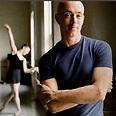
Ballet tells of Holocaust through dance
After premiering in Texas in 2005 and being replicated across US, ballet based on Shoah survivor's story arrives in Israel for first time. Project created in response to 9/11 terror attacks in bid to promote tolerance, fight bigotry and hate
The ballet is based on the story of Naomi Warren, a Holocaust survivor who was held in three concentration camps and lost most of her family during World War II.
Video courtesy of jn1.tv
The ballet premiered in Austin, Texas in 2005 and has since been replicated across the United States. Now it’s coming to Israel for the first time.
Ballet Austin's choreographer and artistic director Stephen Mills created the project as a response to the September 11, 2001 attacks on New York's World Trade Center.
He says his hope for the ballet is to promote tolerance and fight bigotry and hate. He believes dance is one of the most appropriate ways of dealing with intense emotions.
"There's a range of dance styles, some classical dance styles, some folk dance styles, and then very contemporary grounded dance styles, as a way of metaphorically talking about positivity and the evolving of lives that would have happened during that period," he says.
Mills conducted extensive research into the Nazi Holocaust for his piece, including paying visits to key sites around Europe and meeting Holocaust survivors. He says the experience left a deep impression on him and that he fears the phrase "never again" could prove false. The ballet ends, however, as requested by survivor Naomi Warren, with a glimmer of hope.

Ballet Austin. Non-Jewish dancers (Photo: Tony Spielberg)
"The last section, which we call 'Hush,' to me is really reminiscent of the idea if you go to the ghetto fighter's house, or if you go to Yad Vashem, at the end you've seen all of what took place but there's always a place for you to come back to your reality, to know that did not happen to you but that you are responsible," he says. "Once you know something, you can't un-know it, and it is a call to action really, and so the dance ends up in a very positive way."
Ballet Austin came to Israel for two weeks after being invited by the Akko Theater Festival. The event’s director, Albert Shlush, said he was impressed that a troupe of non-Jewish dancers was so intensely interested in the story of Holocaust.
"I was so surprised that non-Jewish people – no one is Jewish in the group – feel the story of the Holocaust so deep inside, and they so much want to come to Israel to perform. I said, 'I will do everything for you to come to Israel.'"
Israeli theatre goers were similarly impressed, saying they were glad to see the story of the Holocaust told in a unique way.
"I think to use art to talk about the Holocaust is the best way," says Haifa resident Yael Tirosh. "Because we are hearing so much about the Holocaust and we're talking so much about the Holocaust and we know so much and we see movies that see this horror, and we long for something else. The youth long for something else, to see another point of view, to see something they can connect to."
Akko resident Freddy Shechter says that years ago "it was something that was untouchable in the arts… The Holocaust was something too big, but I think that today it's a part of life and it has to be like this."
Ballet Austin's final performance in Israel took place in the Beit Haam auditorium, where senior Nazi organizer Adolf Eichmann stood trial 50 years ago before being hanged.










